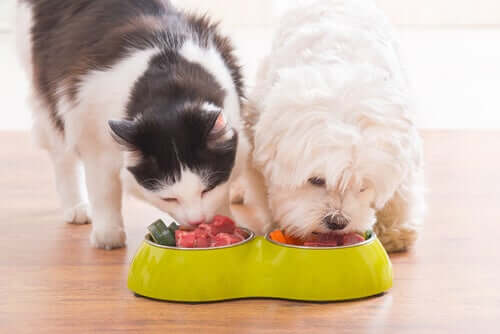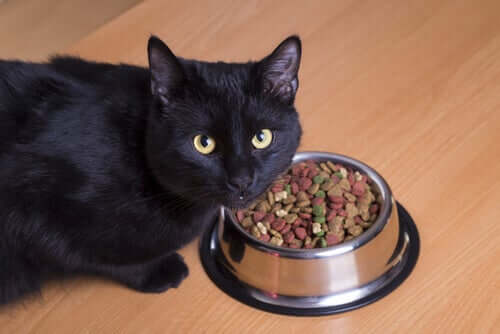Why Cat Food And Dog Food Are Different


Written and verified by the lawyer Francisco María García
Each animal species has its own nutritional requirements and needs a specific diet for its body to function correctly. This is why cat food and dog food are different. Today, we’ll tell you more about why this is and why it matters.
Unlike cats and dogs, human beings are quite unique in this aspect as a result of their evolution. They’re omnivores that can tolerate a more varied diet.
Wild and domestic animals
Wild animals have much more specific and restricted diets. Certain animals and herbivores will graze whilst carnivores hunt for fresh meat.
Cats and dogs descend from big cats and wolves, but domestication has led to a change in their eating habits. Domestic animals can’t hunt for their food, and at first, human food was given to them. But it’s since been proven that eating cooked food causes damage to their digestive processes.

This has led to the emergence of balanced pet foods. These products aim to provide specific percentages of natural nutrients depending on the stage of the animal’s life.
This means that cat food and dog food are different because they are trying to satisfy each animal’s specific nutritional needs.
The main ways cat food and dog food are different
Without being too blunt, dogs are more greedy and tend to be less fussy. Cats, on the other hand, are much more picky eaters.
It’s quite rare for a dog to reject food. They tend to eat everything they see, often without chewing, which can lead to problems like stomach torsion.
Cats are quite selective and will refuse to eat something if they don’t like the taste or the way it smells. They also often leave food in their bowl and very rarely eat a lot of food at the same time.
Imbalance in dogs
All of this can lead to health problems for dogs, and they can easily get a nutritional deficiency. If your pet seems happy to eat what you give them, then it’s not going to be easy for you to realize that maybe that food isn’t right for them. Cats, on the other hand, will make it quite clear when something isn’t to their taste.
Another important thing to consider is hydration. Dogs drink a lot of water every day, whereas cats may go days without drinking anything. This can cause urinary tract problems. As a result, many owners opt to feed their cats wet food to keep them hydrated.
What happens if a cat eats dog food or vice versa?
It’s a common belief that a cat will die if they eat dog food. There can be quite a lot of exaggerated myths out there and you should be careful not to believe everything you hear.
Dog food obviously has a different composition from cat food because it’s designed for dogs and not cats. The differences between canines and felines go beyond just behavior and appearances.
Dogs are omnivores, which is something they inherited from wolves, who in turn picked up their habits by living alongside humans. Cats, on the other hand, are carnivores.
This difference is reflected in the different foods that are available to them. Dog food is reinforced with beta-carotene, which the body turns into vitamin A. It also usually contains multiple plant extracts in order to improve digestion and complement an omnivore’s diet.
A cat’s diet, on the other hand, needs meat proteins, so cat food has a high protein content.

Taurine is a fundamental amino acid needed for muscle development and cell reproduction. Dogs produce it naturally, so dog food doesn’t contain taurine.
If one eats the other’s food…
If a cat regularly eats dog food, it will start to show symptoms of a nutritional deficiency. Its immune system will get weaker and it will eventually become seriously ill.
If dogs eat cat food, they will also have a lack of some nutrients in the body. Too much protein and fat can also lead to diarrhea and vomiting. In more serious cases, they can suffer liver and kidney damage.
Cat food and dog food are different because cats and dogs’ bodies are different and they have specific nutritional needs if they’re to develop properly. If you notice any nutritional deficiency in your pet, make sure you take them to a vet as soon as possible.
Main image source: Brittany Randolph.
Each animal species has its own nutritional requirements and needs a specific diet for its body to function correctly. This is why cat food and dog food are different. Today, we’ll tell you more about why this is and why it matters.
Unlike cats and dogs, human beings are quite unique in this aspect as a result of their evolution. They’re omnivores that can tolerate a more varied diet.
Wild and domestic animals
Wild animals have much more specific and restricted diets. Certain animals and herbivores will graze whilst carnivores hunt for fresh meat.
Cats and dogs descend from big cats and wolves, but domestication has led to a change in their eating habits. Domestic animals can’t hunt for their food, and at first, human food was given to them. But it’s since been proven that eating cooked food causes damage to their digestive processes.

This has led to the emergence of balanced pet foods. These products aim to provide specific percentages of natural nutrients depending on the stage of the animal’s life.
This means that cat food and dog food are different because they are trying to satisfy each animal’s specific nutritional needs.
The main ways cat food and dog food are different
Without being too blunt, dogs are more greedy and tend to be less fussy. Cats, on the other hand, are much more picky eaters.
It’s quite rare for a dog to reject food. They tend to eat everything they see, often without chewing, which can lead to problems like stomach torsion.
Cats are quite selective and will refuse to eat something if they don’t like the taste or the way it smells. They also often leave food in their bowl and very rarely eat a lot of food at the same time.
Imbalance in dogs
All of this can lead to health problems for dogs, and they can easily get a nutritional deficiency. If your pet seems happy to eat what you give them, then it’s not going to be easy for you to realize that maybe that food isn’t right for them. Cats, on the other hand, will make it quite clear when something isn’t to their taste.
Another important thing to consider is hydration. Dogs drink a lot of water every day, whereas cats may go days without drinking anything. This can cause urinary tract problems. As a result, many owners opt to feed their cats wet food to keep them hydrated.
What happens if a cat eats dog food or vice versa?
It’s a common belief that a cat will die if they eat dog food. There can be quite a lot of exaggerated myths out there and you should be careful not to believe everything you hear.
Dog food obviously has a different composition from cat food because it’s designed for dogs and not cats. The differences between canines and felines go beyond just behavior and appearances.
Dogs are omnivores, which is something they inherited from wolves, who in turn picked up their habits by living alongside humans. Cats, on the other hand, are carnivores.
This difference is reflected in the different foods that are available to them. Dog food is reinforced with beta-carotene, which the body turns into vitamin A. It also usually contains multiple plant extracts in order to improve digestion and complement an omnivore’s diet.
A cat’s diet, on the other hand, needs meat proteins, so cat food has a high protein content.

Taurine is a fundamental amino acid needed for muscle development and cell reproduction. Dogs produce it naturally, so dog food doesn’t contain taurine.
If one eats the other’s food…
If a cat regularly eats dog food, it will start to show symptoms of a nutritional deficiency. Its immune system will get weaker and it will eventually become seriously ill.
If dogs eat cat food, they will also have a lack of some nutrients in the body. Too much protein and fat can also lead to diarrhea and vomiting. In more serious cases, they can suffer liver and kidney damage.
Cat food and dog food are different because cats and dogs’ bodies are different and they have specific nutritional needs if they’re to develop properly. If you notice any nutritional deficiency in your pet, make sure you take them to a vet as soon as possible.
Main image source: Brittany Randolph.
This text is provided for informational purposes only and does not replace consultation with a professional. If in doubt, consult your specialist.








